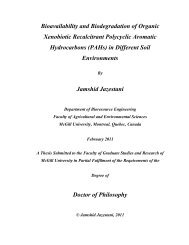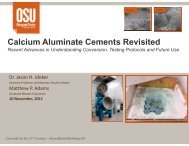i THERMAL PROCESSING EFFECTS ON TOTAL ... - McGill University
i THERMAL PROCESSING EFFECTS ON TOTAL ... - McGill University
i THERMAL PROCESSING EFFECTS ON TOTAL ... - McGill University
Create successful ePaper yourself
Turn your PDF publications into a flip-book with our unique Google optimized e-Paper software.
Sehgal, (1992) reported that roasting may also improve the digestibility, colour, flavor,<br />
shelf life and reduces the anti-nutrient factors of cereals and legumes. Commercial food<br />
processing, by applying heat to seed products, helps to improve their protein quality by<br />
destroying certain anti-nutritional compounds. Thermal treatment such as roasting of<br />
flour by applying dry heat for 6-8 min at 104- 105°C has been shown to reduce its<br />
enzyme activity and lower its trypsin inhibitor and haemagglutinin activities (Aguilera,<br />
Lusas et al., 1982; Smith and Circle, 1972). Therefore, roasting being a simple and cost<br />
effective processing method can be used in developing countries in order to achieve<br />
maximum nutrient utilization from legumes like lentils. Under conventional heating<br />
methods, thermal energy is transferred from the product surface towards its center 10-20<br />
times more slowly than in a microwave-heated product. Roasting has both positive and<br />
negative impacts on legume seeds and flours according to its duration.<br />
2.3.2 Boiling (Hydrothermal processing):<br />
Boiling is one of the commonest methods to cook any form of comestible<br />
legumes. It can be done by two methods: (i) open pan boiling, or (ii) pressure boiling<br />
In the traditional process, comestible legumes are cooked by open pan boiling,<br />
where violent heating may result in loss of water soluble nutrients. Consequently, turning<br />
down the heat once the water starts boiling, in order to slow down the cooking process, is<br />
recommended. Appropriate cooking times for legumes can be affected by genetic factors,<br />
physical structure, chemical composition and processing (Iyer et al., 1989).<br />
Parihar et al., (1999) reported that proportionately more proteins were retained<br />
under both forms of boiling, than fats or carbohydrates. Preliminary studies by Xu and<br />
Chang, (2008) reported that the boiling process significantly reduced total phenolic<br />
contents, free radical scavenging capacity in cool season comestible legumes. Porres,<br />
López-Jurado et al., (2003) found that by pressure cooking lentils at 120°C for 30 min<br />
reduces concentrations of trypsin inhibitor activity, phytate, and tannin content by 76%,<br />
8%, and 12% respectively. In-vitro protein digestibility was improved by 81% after<br />
pressure cooking compared to open pan boiling (Naveeda and Jamuna, 2006). Ur-<br />
12









